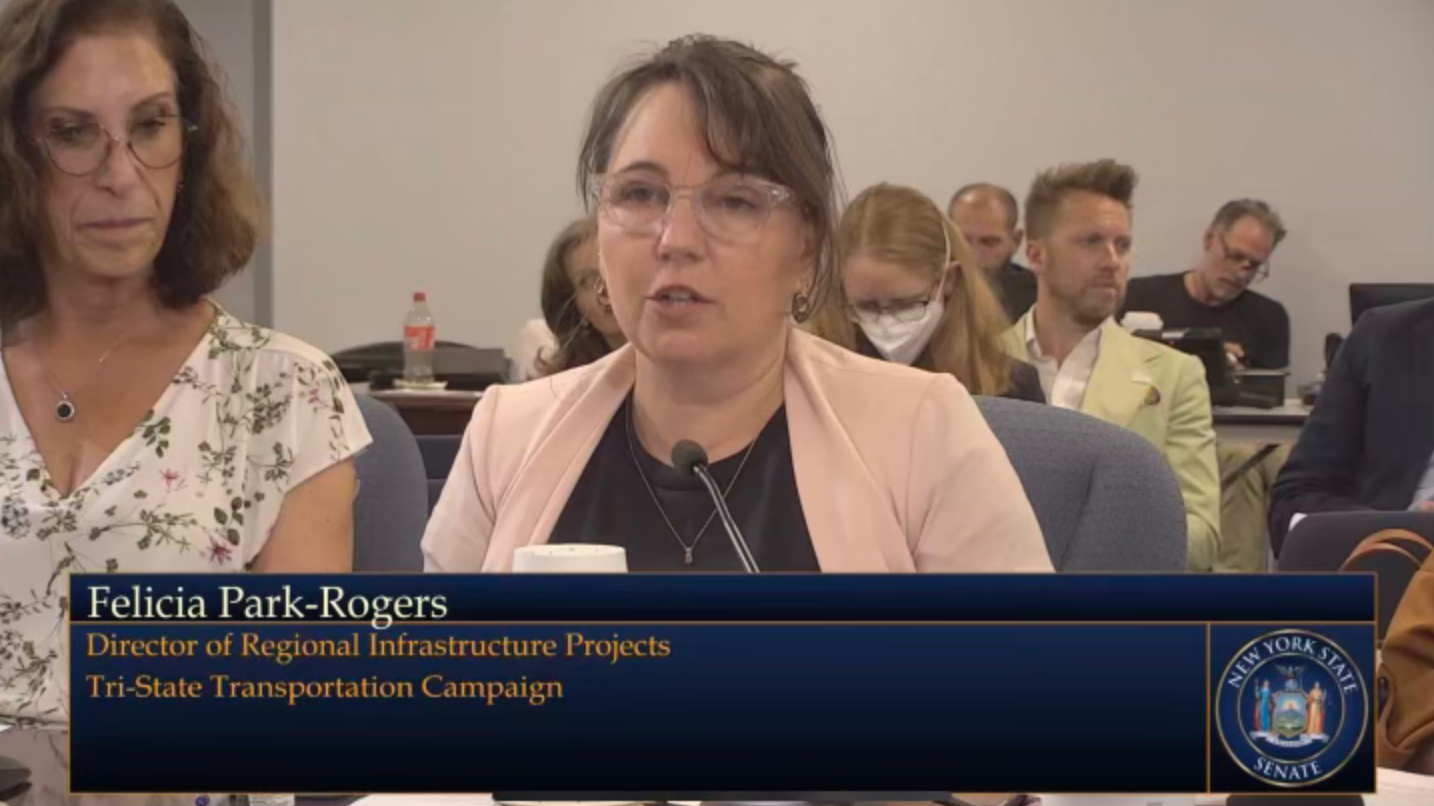Hello. My name is Felicia Park-Rogers, Director of Regional Infrastructure Projects for the Tri-State Transportation Campaign. TSTC is a regional transit and transportation policy, advocacy, and research organization. I have represented TSTC for the past two years as a member of the community advisory committee and working group for ESDC’s Penn Station Area Improvement Project.
The Penn Station area is a linchpin for our region’s transportation network, our economy, our residents, our workers, and the tens of millions of people who visit New York City every year. It is past time to invest in this area. Transit-oriented development is the best type of development for our city, as well as for our collective efforts to combat climate change. Penn Station is operating far beyond capacity and desperately needs to be modernized and improved. New York City, New York State, and our entire region are hindered by the current Penn Station.
However, we have several concerns: First, the primary goal of this GPP is to create funds to improve transit, yet we don’t know how much funding will be created or the timeline for when those funds will be available. Value-capture financing rarely creates the amount of revenue promised. Taxpayers are frequently left on the hook in what essentially becomes a plan to subsidize large developers by reducing their property tax burdens. What is the contingency plan if the anticipated funding from the PILOT doesn’t materialize? Who pays then? Today, President Davis suggested it will be the State of New York.
TSTC also has serious concerns about the current plan for renovating the original Penn Station. Obviously, a massive renovation is desperately needed for this antiquated, unsafe, horrible station. But, good transit planning starts with function first and is then followed by form. A pretty new station does New Yorkers no good if trains are still late, platforms are still unsafe, and service is still unreliable and fragmented.
The new Hudson Tunnels and the improvements to the Northeast Corridor undeniably comprise the most important infrastructure project in our region and the nation. But, to fix Penn Station, we must fix the tracks and platforms, and then design a new station around those. None of these plans even touch the current tracks or platforms.
Just this week, TSTC produced a report envisioning the transformation of our region’s segmented and bifurcated rail systems into one seamless regional rail system. Our report includes a modified plan which allows for some expansion, more through-running, and attempts to save more of the existing Block 780.
You must demand transparency from the railroads and receive their commitment to perform an honest, rigorous, thorough analysis, including a cost-benefit analysis, of the best alternatives to improve the tracks, platforms, and capacity of Penn Station.
We must learn from the mistakes that were made with the LaGuardia AirTrain project, in which one alternative was verifiably the preferred outcome and the other three alternatives were designed to fail. It is important that the railroads perform a transparent analysis of all four options, including the through-running alternative.
While the Penn Station renovation is a creative attempt to work around the massive constraints placed upon it by Madison Square Garden and 2 Penn, those constraints lead to multiple problems for the station and its riders, as well as the taxpayers. The estimated cost of $7 billion dollars is enormous. Moynihan Station, for example, cost $1.3 billion dollars. Why is the cost so high? One reason is that it will require significant expense to overcome the structural constraints placed on the station due to Madison Square Garden being on top of it. Another reason is that the MTA will have to pay to rebuild the Madison Square Garden Skyway to 7th Avenue, as well as pay to move their loading zone underground to build the proposed concourse between 31st and 33rd Streets.
Not only is this exorbitantly expensive, it means that the station entrances and exits will be mid-block rather than exiting onto 7th and 8th Avenues, where most riders actually want to exit to reach their destinations. Madison Square Garden benefits tremendously from sitting atop the nation’s largest train station, yet they refuse to engage in any meaningful negotiations to make the space work better for the city, the region, the riders, and even for themselves. Madison Square Garden by state statute pays no taxes to the city. The last time an estimate was done, this was approximately $40 million dollars in lost annual tax revenue. These are funds that could, for example, be bonded against through a TIFF to be applied towards transit improvements at Penn Station.
There is a very real possibility that Madison Square Garden could decide to move its venue at any time, at which point our taxpayers will have paid $7 billion dollars to build an underground station and a glass concourse mid-block, not having re-worked the platforms or tracks, and leaving an outdated, far from state-of-the-art, possibly empty stadium atop what should be the pride and joy of the State’s transportation network.
In summary, Tri-State Transportation Campaign recommends:
- Make meaningful improvements to the GPP plan as outlined in detail by the CAC-WG. Governor Hochul’s revisions to the proposed project were not substantive. They did little to address the concerns raised by stakeholders and the CAC-WG. To restore faith with the public, it is imperative that ESDC incorporate the changes recommended by the community advisory committee, which includes many of our city’s premier urban planning leaders, advocacy and civic groups, and community representatives.
- Include MSG and 2 Penn in the GPP. It makes zero sense that those are not part of the area improvement plan when they create the largest impediments to improving the transit system.
- Don’t move forward without a detailed, verifiable funding mechanism for the transit improvements in the GPP, which includes a contingency plan if that anticipated funding doesn’t materialize.
- Insist on a robust preliminary analysis of the four alternatives, including a legitimate analysis of increasing the through-running capabilities at Penn Station, which could help avoid the need for eminent domain of a large portion of Block 780.
- Lastly, pass legislation revoking the tax abatement of MSG. Engage the owners of MSG in serious and robust negotiations to work together to improve transit, access, safety, and reliability for riders. With MSG as an engaged partner, it’s a given that they will continue to benefit tremendously from their premier transit location.
Thank you for your consideration and investigation into this monumental project.

